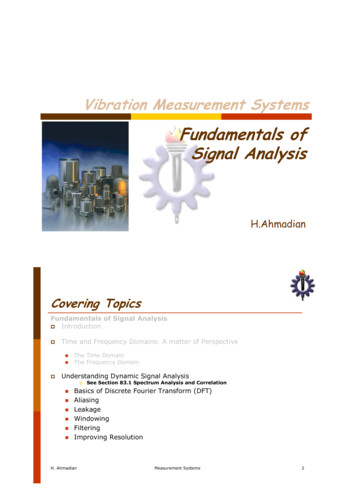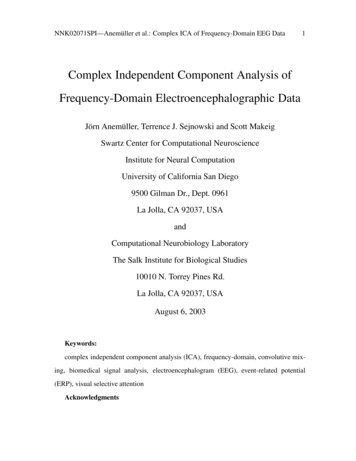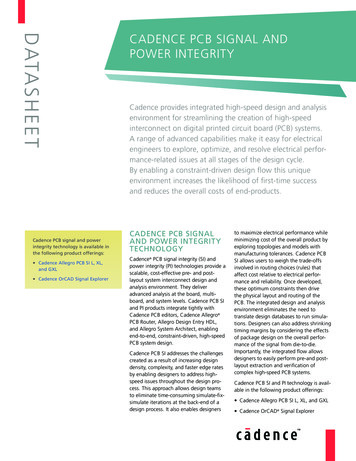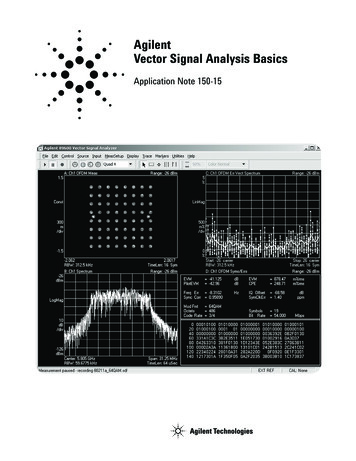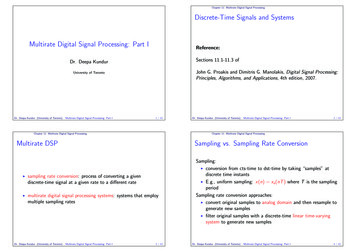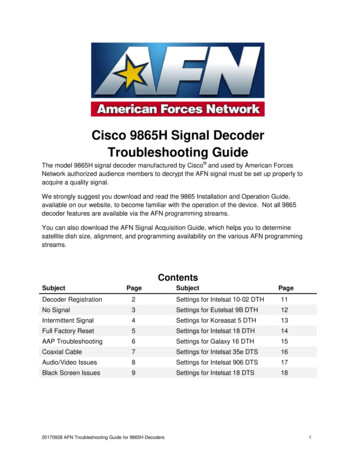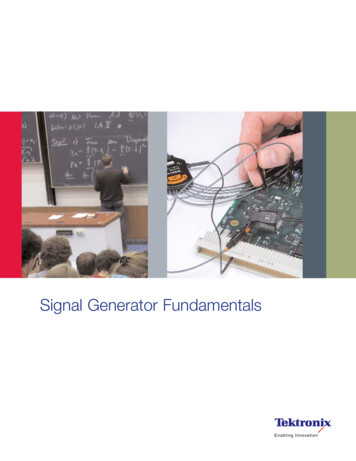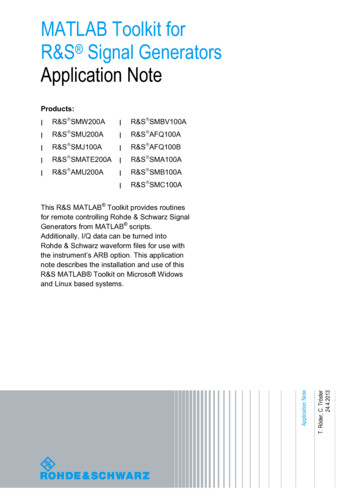
Transcription
ElectroencephalogramSignal Analysis
ElectroencephalogramSignal Analysis:Epileptic Cerebral ActivityLocalization andImplementationEdited bySalah Hamdi
Electroencephalogram Signal Analysis:Epileptic Cerebral Activity Localization and ImplementationEdited by Salah HamdiThis book first published 2022Cambridge Scholars PublishingLady Stephenson Library, Newcastle upon Tyne, NE6 2PA, UKBritish Library Cataloguing in Publication DataA catalogue record for this book is available from the British LibraryCopyright 2022 by Salah Hamdi and contributorsAll rights for this book reserved. No part of this book may be reproduced,stored in a retrieval system, or transmitted, in any form or by any means,electronic, mechanical, photocopying, recording or otherwise, withoutthe prior permission of the copyright owner.ISBN (10): 1-5275-8451-8ISBN (13): 978-1-5275-8451-8
CONTENTSForeword . viChapter 1 . 1PrefaceMohamed Hédi BedouiChapter 2 . 4EEG Signal Pre-Processing MethodsSalah Hamdi, Mohamed Hédi BedouiChapter 3 . 41Analysis and Automatic Classification of Vigilance States by KohonenNeural NetworksKhaled Ben Khalifa, Mohamed Hédi BedouiChapter 4 . 68Learning Machine for the Classification of Epileptic Cerebral ActivityIbtihel Nouira, Mohamed Hédi BedouiChapter 5 . 97Parallel Implementation for EEG Artifact RejectionIbtihel Nouira, Mohamed Hédi BedouiChapter 6 . 120EEG Signals Modeling using VAR ModelSalah Hamdi, Mohamed Hédi Bedoui, Najeh ChaâbaneChapter 7 . 162InferenceSalah Hamdi, Mohamed Hédi BedouiAcknowledgement . 165
FOREWORDThe electroencephalogram (EEG), which records electrical activity inthe brain, is quickly becoming a standard tool for studying human brainfunctioning and diagnosing different mental and neurological illnesses. Infact, the analysis of EEG data has been identified as the most prevalenttechnique to the challenge of obtaining knowledge on brain dynamics.Data analytics, machine learning, and artificial intelligence (AI), as well asbiomedical engineering, are examples of computational, mathematical, andengineering domains that are fast evolving. A thorough, accessible, andresearch-informed book on current breakthroughs in biological signalprocessing is long needed.EEG Signal Analysis: Epileptic Cerebral Activity Localization andParallel Implementation, edited by a team of scholars with expertise in thefield of medicine, computer science, electronics and quantitative methodssatisfy this requirement by reporting on the most recent breakthroughs inEEG signal analysis.Dr. Salah Hamdi received his PhD in 2016, and has been at theLaboratory of Technology and Medical Imaging at the Faculty ofMedicine of Monastir, University of Monastir since 2009. Currently, he isPrincipal Professor Emeritus at the Higher Institute of Finance andtaxation of Sousse. One of his main areas of research is that of computerscience, AI and signal analysis.Dr. Ibtihel Nouira, received her Ph.D degree in electronics from theNational School of Computer Sciences (ENSI) in 2015, Tunisia.Currently, she is member of the research Laboratory of Technology andMedical Imaging (LTIM) at the Faculty of Medicine of Monastir (FMM).Her current research topics focus on medical imaging and signals.Dr. Khaled Ben Khalifa, received his Ph.D degree in PhysicsElectronics from the Faculty of Sciences of Monastir, in collaboration withINRIA Nancy Grand Est Research Center, France, in 2006. After apostgraduate degree in Materials and Devices for Electronics at theFaculty of Sciences of Monastir, he defended a PhD in applied Electronicsin biomedical tools and whose subject focused on the study and design ofan ambulatory electronic system for the assessment of the levels of humanvigilance in real time.
Electroencephalogram Signal Analysis: Epileptic Cerebral ActivityLocalization and ImplementationviiDr. Najeh Chaâbane received his PhD in Quantitative Economics fromUniversity of Sousse (2013). He is an Assistant Professor in theEconomics and Quantitative Methods Department, Faculty of EconomicSciences and Management of Sousse. His dissertation and subsequentresearch has focused on data analysis, computational statistics andeconometrics.Prof. Mohamed Hédi Bedoui, received his Ph.D degree in Genie Biomedical from University of Lille France in 1992. Full Professor andChairman of the Communication Committee and Resources in the Facultyof Medicine of Monastir. Leader of the Research laboratory of Technologyand Medical Imaging. His current interests include the conception ofelectronic and informatics systems used in the medical field.The edited EEG Signal Modeling and Classification: EpilepticCerebral Activity Localization and Parallel Implementation collection isstructured in five chapters. The first chapter is devoted to providing a fulloverview and a comprehensive introduction of EEG signal processingmethods. The second one deals with neural methods to EEG signalclassification. The book explains how machine learning may be used forlocating epileptic brain activity in the third part. The fourth chapterexplains a parallel implementation for EEG artifact elimination. Finally,the book uses VAR models to investigate correlation and causationbetween EEG signals.The book provides an extensive and modern assessment of advancementsin this fast-moving topic for academic scholars and practitioners. The bookprovides a multidisciplinary update on biological signal methodologiesand applications with contributors from diverse fields of research. Weneed to process biological signals more than ever with the health andmedical concerns facing the rising and aging population of the planet.This edited collection is a contemporary and great resource for studentsand researchers that deal with a range of data, data and signal processingtechniques. The collection is highly suitable for undergraduates andgraduate students.
CHAPTER 1PREFACEMOHAMED HÉDI ory of Technology and Medical ImagingFaculty of Medicine of Monastir, University of Monastir, Monastir 5019,Tunisiamedhedi.bedoui@fmm.rnu.tnThe progress of digital electronics and computer technologies issweeping through all areas of daily life, especially the biomedical field. Inthis context, an important artificial vision peculiarity should be noted. Infact, more and more importance is being given to the exploitation of visualinformation. To ensure reliable treatment of the human health condition,the development of an intelligent environment for analyzing physiologicalsignals will be a primary goal for many clinicians.In medical signal processing, doctors generally establish their diagnosisby mentally inferring the dynamic behavior of the organ (brain, heart,etc.), from temporal plots of its electrical activities. This process requires agreat deal of experience. It is difficult, subjective and not very precise.Automated tools are now asserting themselves as a major new medicaltechnology aimed at performing real-time processing of the traces ofphysiological signals, more particularly electroencephalogram (EEG)signals and carrying out monitoring over long periods of time.Given the importance of the brain, several medical imaging techniquestoday allow precise access to the anatomy of the brain as well as to brainactivity. Among these techniques are Positron Emission Tomography(PET), Mono-Photon Emission Tomography (TEMP-SPECT), FunctionalMagnetic Resonance Imaging (fMRI), Magnetic Resonance Imaging (MRI),Electroencephalography (EEG) and Magnetoencephalography (MEG)).A priori, the EEG technique is of great interest since it gives goodtemporal resolution at the scale of these processes. The Technologies and
2Chapter 1Medical Imaging Laboratory (LTIM) of the Faculty of Medicine ofMonastir has enough scientific and clinical skills in processing andanalyzing physiological signals, particularly EEG.Through this book, we were interested in different applications ofprocessing and analysis of EEG signals based on advanced intelligentmethodologies in the field of signal processing. Three applicationobjectives were carried out. The first objective was to contribute to thefield of EEG signal preprocessing through developing tools for filteringEEG signals by integrating automated methods in order to detect andremove the different types of artifacts. The methods proposed for thefiltering allow to further refine the diagnosis by the efficiency andperformance of suppressing noise embedded in EEG signals. In fact, anapplication of physiological EEG signals classification poses manyproblems because of the shape complexity and the variation in morphologyof these signals, the presence of the artifacts and the complexity of readingthe EEG signals. To remedy these problems, the use of intelligenttechniques (neural networks and machine learning) represents a necessarystep in the work of this book. However, the computational complexity ofEEG signal analysis applications is incompatible with the use of sequentialcomputations. Parallelism is one of the solutions that aims to speed upalgorithms related to the processing of brain signals. The highlyspecialized parallel architecture optimized for intensive parallel computingjustifies the choice of using GPU graphics processor. GPU cards also helpreduce overall system consumption. The specifics of GPU computing arenot just limited to the change of language. The way calculations arehandled is different. Independent operations, whether sequential orparallel, occur very quickly and recursive calculations do not saturate themachines.Chapter 1 of this book is a general introduction presenting the generalbook theme. Chapter 2 shows to reader what kind of relevant informationcan be extracted from EEG signals. The main sources of information arespectral information, which is used with band power characteristics,temporal information, typically represented as the amplitude of preprocessedEEG signals over time, and the spatial information, which can be exploitedby focusing on certain sensors or by using spatial filters. Moreover weprovide a comparative study between different kinds of methods: tempofrequency, spatial and adaptive. An evaluation based on accuracyperformance criteria is carried out.In chapter 3, neuronal approaches and learning machines for EEGsignal classification are presented. Several studies have been carried out,using artificial neural networks, to discriminate vigilance states in humans
Preface3from electroencephalographic signals. Connectionist methods withsupervised and unsupervised training have been used to discriminate theEEG signals characterizing the decrease in vigilance. Furthermore, animplementation of connectionist system onto hardware devices using havebeen realized.Chapter 4 is a complement to the previous chapter. This chapter describesan intelligent system based on of Support Vector Machine (SVM). Thissystem was able to detect epileptic seizures from electroencephalogram(EEG) signals. An implementation of the developed system was realizedon a Graphics Processing Unit (GPU) by exploiting parallel computing. Aparallel implementation of the proposed system was developed based onGraphics Processing Unit (GPU) using Compute Unified Device Architecture(CUDA) description.In chapter 5, a parallel implementation for EEG artifact rejection wasapplied on the EFICA-DWT filtering method which combines theEfficient Fast Independent Component Analysis (EFICA) and DiscreteWavelet Transform (DWT) techniques. Three methods were developedbased on GPU Matlab in order to optimise the EFICA-DWT executiontime compared to a Central Processing Unit (CPU) implementation.Chapter 6 presents an EEG signal modeling using VAR model bytaking and analyzing measurements in large quantities of EEG and ECGsignals. This chapter examines the cognitive and cardiovascular systemfunction simultaneously to seek statistical causality between EEG andECG signals.
CHAPTER 2EEG SIGNAL PRE-PROCESSING METHODSSALAH HAMDIhttps://orcid.org/0000-0001-7870-9536MOHAMED HÉDI ory of Technology and Medical ImagingFaculty of Medicine of Monastir, University of Monastir, Monastir 5019,Tunisiasalah.hamdi@isffs.u-sousse.tn, medhedi.bedoui@fmm.rnu.tnAbstract: EEG signal recordings are always accompanied by interferenceand artifacts, requiring the addition of a filtering step which aims atkeeping only useful information related to the movements of the lower andupper limbs. Since EEG signals have statistical properties dependent ontime, frequency and space, the preprocessing phase incorporates frequency,time or spatial filtering techniques. In addition, given the large size of theEEG signals acquired as well as the presence of a strong informationredundancy, it is necessary to use a second characteristic extraction stagemaking it possible to reduce the size of the signals while keeping thediscriminative information. The extracted features are useful forclassification.Keywords: Nervous system, EEG signal, Brain Computer Interface,Filtering methods.
EEG Signal Pre-Processing Methods51. IntroductionThe nervous system is the medium responsible for knowledge,reflection and action. As part of the analysis and interpretation ofphysiological processes, sophisticated devices have been created to recordthe response of neurons to different types of stimuli. Several non-invasivetechniques have made it possible to study cognitive processes andpathological activities. Numerous studies have provided a betterunderstanding of how the brain works and improved clinical diagnosissuch as encephalography. The electroencephalogram (EEG) is a plotrepresenting the potential difference between two electrodes placed on thescalp. This signal has become very widespread and can describe theactivity of the brain and its changes during cognitive tasks in a clinicalsetting. Indeed, the EEG signal is used for the diagnosis and monitoring ofmany pathologies of the central nervous system such as epilepsy and sleepdisorders.However, Brain-Computer Interfaces (BCI) has demonstrated limits inperformance, stability, robustness, and calibration time and noisesensitivity. Thus, several studies are considering developing robust EEGsignal processing algorithms with short calibration times, in order to createpractical BCIs, usable and useful outside of laboratories.In this chapter, we will talk about the nervous system and therecordings of EEG signals using brain-computer interfaces. In addition apart is to describe the EEG signal and its characteristics. In addition, alarge part is prepared to present the different techniques of temporal,frequency and spatial filtering of the EEG signal.2. Nervous systemThe nervous system is made up of the brain, the brainstem, the spinalcord, and the nerves that connect this system to the rest of the body. Thebrain is divided into sub areas responsible for different tasks: vision,touch, memory [9]. This information is transmitted from one neuron toanother by action potentials. These action potentials will give rise topostsynaptic potentials, which in turn can lead to action potentials when athreshold is reached. The nerves enable the coordination between thedifferent parts of the human body, as well as the reception of messagesrelated to sensations. The nervous system is also the seat of cognition, thatis to say the means to achieve knowledge [5]. The overall nervous systemis shown in Figure 1. It can be divided into two parts:
Chapter 26 The central nervous system (CNS), which contains the spinal cordand brain. The peripheral nervous system (PNS), which contains the spinalnerves coming out of the spinal cord.Figure 1: Nervous systemThe brain is responsible for the connection between the externalenvironment and the internal one in order to manage all human reactions.It is made up of three main parts: The brainstem The cerebellum The brainThe brainstem is an extension of the spinal cord made up of two typesof nervous tissue: white matter at the periphery, and gray matter in thecenter, unlike the brain. Two types of information pass through the trunkand spinal cord, sensory and motor. The cerebellum is the part immediatelybelow the brain and behind the brainstem. It manages nerve impulses andorders from the brain and changes them based on information from nerveendings distributed throughout the body. Thus, it controls muscle tone bysending regulatory signals to motor neurons in the brain and spinal cord.Damage to the cerebellum causes loss of muscle coordination and disruptsmovement [6].
EEG Signal Pre-Processing Methods7It is very difficult to attribute a given function to a limited part of thebrain, because the processing of information takes place throughinterconnected regions. Primary areas receive information from higherareas that play a role in the perception of the outside world. However,there are dominant ones. The frontal lobe is heavily involved in cognitivetasks such as memory, reasoning, and associative conceptualization. Theoccipital lobe helps manage the processes of vision. The parietal lobe isinvolved in the analysis of touch. The temporal lobe is used to manageauditory and olfactory information. Each of the two hemispheres isdivided into four lobes which are the frontal lobe located just behind theforehead, the temporal lobe located at the temples and below the frontallobe, the parietal lobe located behind the frontal lobe and the occipitallobe, which is located at the rearmost part of the skull [7]. The cerebellumlies below the occipital and temporal lobes.There are about eight billion neurons in the brain. Neurons areorganized according to two scales: Global communication network that links the different corticalregions together. Local network in order to process information within the samestructure.Figure 2 shows the neuron as a cell that receives, propagates, andtransmits the electrical signals constituting the nerve impulse [51]. Thesesignals are transmitted from one cell to another through specializedcontacts: the synapses. The neuron is characterized by a cell body thatcontains the nucleus and its genetic material.Two types of extension start from the cell body: The dendrites, numerous and highly branched, which receiveinformation and send it to the cell body. The axon which transmits signals to other neurons. A neuron canhave thousands of synaptic contacts with other neurons.
Chapter 28Figure 2: NeuronThe synapse represents a functional contact zone between two neurons,but also between a neuron and another cell [9]. In the case of neuronalsynapses, this contact is made between a presynaptic neuron via the axonand a postsynaptic neuron. There are two types of synapses: Chemical synapses Electrical synapsesChemical synapses are in the majority and characterized by thepresence of a space between the presynaptic element and the postsynapticelement called the synaptic cleft. The electrical information is thentransformed into chemical information through the release ofneurotransmitters contained in the presynaptic vesicles.Electrical synapses are communicating junctions where electricalinformation is transmitted directly without any chemical intermediary.Synaptic transmission is a polarized one-way transmission connecting thepresynaptic element containing the neurotransmitter with the postsynapticelement where the neurotransmitter is located.The arrival of action potentials in the presynaptic element results incalcium entry and fusion of synaptic vesicles with the plasma membrane.This fusion of the synaptic vesicles with the membrane exocyticallyreleases the neurotransmitter into the synaptic cleft. The releasedneurotransmitters can attach to receptors located on the postsynaptic
EEG Signal Pre-Processing Methods9element. This binding causes ions to pass through the postsynapticmembrane through the opening of ion channels. When the membranereaches a certain potential, an action potential is triggered. It is thereforethe transformation of a chemical signal into an electrical signal.3. EEG signal recordingEEG signals can be recorded using electrodes placed on the head orimplanted directly into the skull to make an intra-cerebral recording. Theelectrodes are illustrated in Figure 3 and they require the use of gel.However, the gel can cause artifacts and takes some time to apply. Indeed,there are works carried out experiments using dry electrodes. The goal isto have a measurable EEG signal, since interactions between neurons giverise to ionic currents generating action potentials. Practically, ioniccurrents resulting from dendritic electrical activity represent the majorityof the brain-derived EEG signal collected from the scalp.Postsynaptic events are at the origin of EEG through their duration of afew tens of milliseconds while the action potential lasts only a fewmilliseconds.The acquired EEG signals’ amplitude is about 1 mv. In order to be ableto detect them correctly by signal processing systems, these signals mustbe amplified before their digitization so that the variations of the voltagescan be displayed in graphic form (paper or screen) or recorded in areadable manner in a standard format. This amplification uses adifferential amplifier which measures and amplifies the difference inpotentials between a pair of electrodes. Amplification is characterized byits amplification factor which can reach 106 according to cascadearchitecture of differential amplifiers. These are modeled by voltagegenerators which can thus adjust the Common-mode-rejection ratio:(CMRR) which exceeds 80 dB for modern acquisition systems. Thepotential difference causes a variation in the bandwidth of the recordedEEG signals exceeding the tolerated limits between 0 and 100 Hz.
10Chapter 2Figure 3: EEG signal recordingThere are two types of currents: Primary currents: these are generated at the level of a neuron. Secondary currents: they result from the synchronous superpositionof the primary currents generated by pyramidal neurons parallel toeach other and perpendicular to the surface of the cortex.The factors that affect the EEG signal are: The distance between the recording electrodes and the source of thesynaptic currents. The duration and number of synchronized synaptic potentials.
EEG Signal Pre-Processing Methods11 The geometric orientation of neurons that generate extracellularelectrical potentials.The electrodes are used to collect the signal on the subject's scalp, andshould not polarize. They are most often made of chlorinated silver andplaced by a helmet surrounding the subject's head, or by fixation with acolloidal gel.Currently, recent systems can achieve 128 or even 256 electrodes. Animportant factor to take into account is the proper spatial sampling ofelectrical potentials [8]. Previously, the electrodes were placed accordingto the international system ‘10-20 ’based on 19 electrodes or ‘10 -10’based on 64 electrodes. Figure 4 shows the international ‘10-20’ system.An electrode is identified by a letter followed by a number. The letterspecifies the region as follow: F: frontalT: temporalC: centralP: parietalO: occipitalThe numbers specify the hemisphere. Even numbers are for the righthemisphere and odd numbers are for the left hemisphere. The 𝑧 letterrefers to the electrodes placed on the center line.Figure 4: EEG Helmet and international 10-20 system
12Chapter 2There are two main types of assembly: Bipolar assemblies: the activities obtained are the result of thesubtraction of two consecutive electrodes, which cancels the effectof the recording reference on re-reading. Reference assemblies: electrical activity is recorded against anidentical reference electrode for all channels.Each of the recording methods has advantages and disadvantages.Indeed, the surface EEG has the advantage of a simple set-up and a globalvision with high temporal precision.However, the signals are disturbed by different types of artifacts whichsometimes have very large amplitudes and can drown out actual brainactivity. The sensitivity of recordings to temporal lobe activities is also anunresolved issue. Thus, the extraction of signals generated by an EEGstimulus often requires several iterations of stimuli in order to minimizenoise.For intra-cerebral recording, the depth electrodes are implanted directlyinto the skull during an operation under general anesthesia. This results insignals having a very good signal-to-noise ratio, while directly recordingthe cerebral structures therefore with very high spatial specificity.4. Brain-computer interfaceBrain-Computer Interfaces (BCIs) have demonstrated their enormouspotential in many applications. However, they remain mainly prototypes,not yet used outside of laboratories. This is mainly due to their followinglimitations: Performance: the low classification precision obtained with BCIsmakes them difficult to use or even simply useless compared toexisting alternative interfaces Stability and robustness: the sensitivity of EEG signals to noise andtheir inherent non-stationary make performance already low anddifficult to maintain over time. Time: the need to adapt the BCI to the EEG signals of each usermakes their calibration times long.Indeed, several studies are thinking of correcting these defects bydesigning robust EEG signal processing algorithms and with shortcalibration times, in order to create practical BCIs. The figure below
EEG Signal Pre-Processing Methods13shows the role of Brain Computer Interface to make EEG signalsrecording.BCIFigure 5: Brain Computer Interfaces and EEG signals recording
14Chapter 2To this end, we explore robust spatial filters to make BCIs moreprecise, more resistant to noise and non-stationary. However, simplyadding more sensors will not solve the performance issues. Indeed, usingmore sensors means extracting more features which further exposes thedimension curse. So adding sensors can even reduce performanceespecially if the number of available learning examples is too low. In orderto efficiently operate multiple sensors, there are three main algorithms toreduce the dimension of the feature vector: Feature selection algorithms, which are methods for automaticallyselecting a relevant subset of features, among all the featuresinitially extracted [26]. Sensor selection algorithms, which are methods for automaticallyselecting a relevant subset of sensors, among all the availablesensors. Spatial filtering algorithms, which are methods combining severalsensors to form a new virtual sensor from which the characteristicswill be extracted.We will focus on spatial filtering, for which EEG and BCI specificalgorithms have been applied. Feature selection is a set of general machinelearning tools, not specific to EEG or BCI. As for the selection of sensors,the algorithms used are generally derived from the feature selectionalgorithm. [2, 48].5. BCI design and EEG features extractionIn the design of BCIs, the processing of EEG signals often relies onmachine learning techniques. This means that the classifier andcharacteristics are adjusted and optimized for each user, based onexamples of that user's EEG signals. These EEG signals are called alearning set. Thanks to this training set, we will be able to calibrate aclassifier so that it can recognize the class of different EEG signals.Usually, features are grouped together in a vector called a “featurevector” [55]. A characteristic is a value describing a property of EEGsignals, for example, the power of the EEG signal in the µ rhythm forelectrode C3.The illustrated Figure 6 depicts that, in order to identify the extractedfeatures in EEG signals, powers are in a specific frequency band. The bandpowers are calculated in the µ (8-12 Hz) and β (16-24 Hz) frequencybands for the electrodes above the sensorimotor cortex. Some
EEG Signal Pre-Processing Methods15characteristics can be classified using a classifier such as LinearDiscrimination Analysis (LDA).Figure 6: Frequency bands of EEG signalFeatures can be optimized through examples of EEG signals byselecting the most relevant electrodes to recognize different mental states.Thus, designing a BCI using machine learning requires: Learning or training phase: which consists of acquiring learningEEG signals and optimizing the processing chain of EEG signalsby adjusting the parameters of the characteristics and / or bytraining a classifier. Test phase: which consists of using the classifier and the obtainedfeatures during the learning phase to recognize the user's mentalstate from new EEG signals.At the end of the learning phase, a classifier capable of learning fromexamples which class corresponds to which input characteristics, must bedesigned. Thanks to “curse-of-dimensionality”, the amount of examplesneeded increases exponentially with the dimension of the feature vector[44]. Studies even recommend using 5 to 10 times more training examplesper class than the dimension of the feature vector.For example, imagine we are using a common EEG system with 32electrodes sampled at 250 H
EEG signals by integrating automated methods in order to detect and remove the different types of artifacts. The methods proposed for the filtering allow to further refine the diagnosis by the efficiency and performance of suppressing noise embedded in EEG signals. In fact, an application of physiological EEG signals classification poses many
